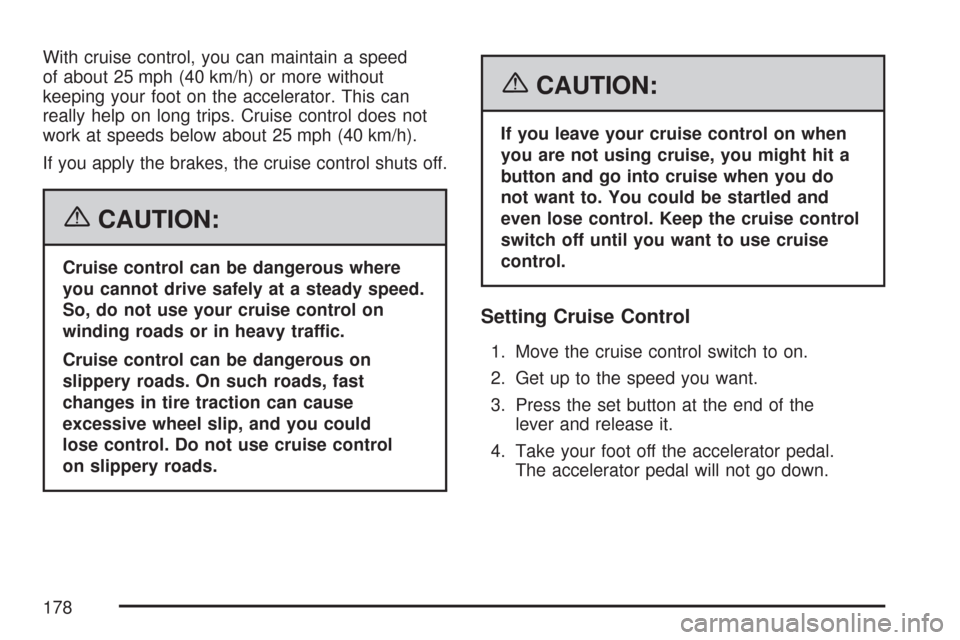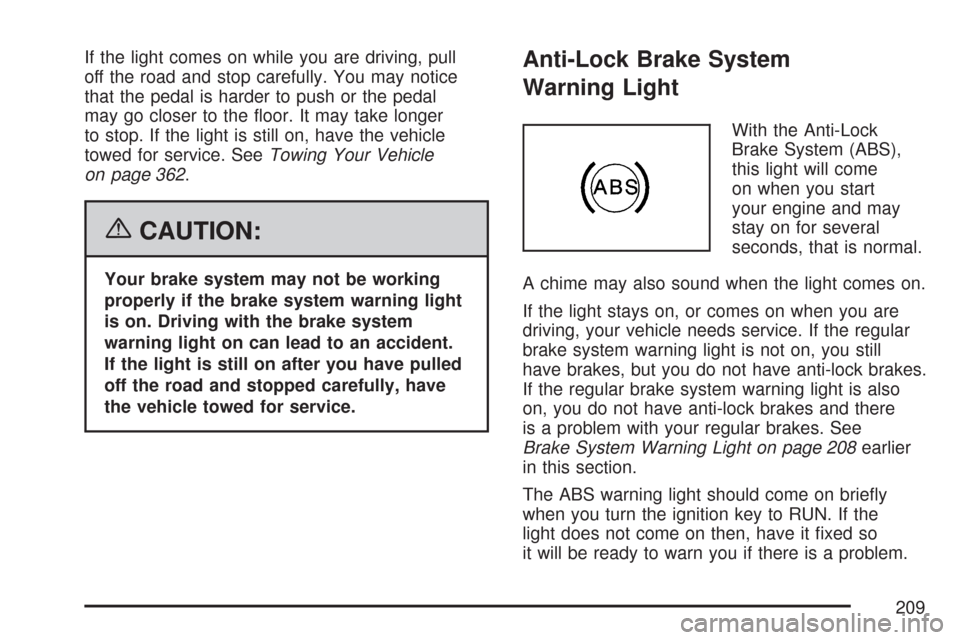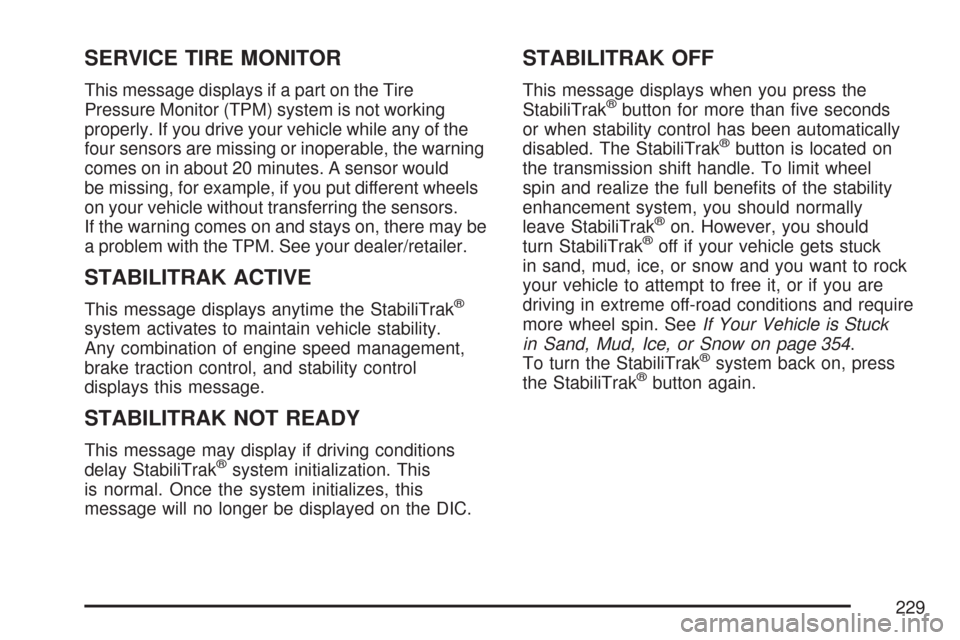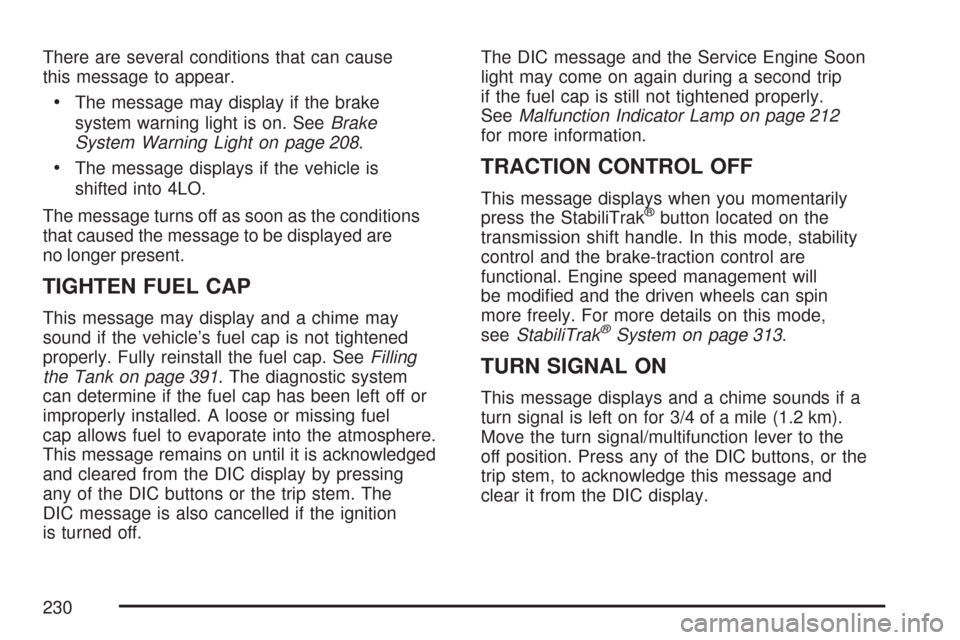2007 CHEVROLET TRAIL BLAZER brake
[x] Cancel search: brakePage 178 of 574

With cruise control, you can maintain a speed
of about 25 mph (40 km/h) or more without
keeping your foot on the accelerator. This can
really help on long trips. Cruise control does not
work at speeds below about 25 mph (40 km/h).
If you apply the brakes, the cruise control shuts off.
{CAUTION:
Cruise control can be dangerous where
you cannot drive safely at a steady speed.
So, do not use your cruise control on
winding roads or in heavy traffic.
Cruise control can be dangerous on
slippery roads. On such roads, fast
changes in tire traction can cause
excessive wheel slip, and you could
lose control. Do not use cruise control
on slippery roads.
{CAUTION:
If you leave your cruise control on when
you are not using cruise, you might hit a
button and go into cruise when you do
not want to. You could be startled and
even lose control. Keep the cruise control
switch off until you want to use cruise
control.
Setting Cruise Control
1. Move the cruise control switch to on.
2. Get up to the speed you want.
3. Press the set button at the end of the
lever and release it.
4. Take your foot off the accelerator pedal.
The accelerator pedal will not go down.
178
Page 179 of 574

Some vehicles have
a cruise light on the
instrument panel
cluster that will come
on when the cruise
control is engaged.
Resuming a Set Speed
Suppose you set your cruise control at a desired
speed and then you apply the brake. This, of
course, shuts off the cruise control. But you do
not need to reset it.
Once you are going about 25 mph (40 km/h) or
more, you can move the cruise control switch
brie�y from on to resume/accelerate.
You will go right back up to the previously chosen
speed and stay there.
If you hold the switch at resume/accelerate, the
vehicle keeps going faster until you release
the switch or apply the brakes. So unless you
want to go faster, do not hold the switch at
resume/accelerate.
Increasing Speed While Using
Cruise Control
There are two ways to go to a higher speed:
Use the accelerator pedal to get to the higher
speed. Press the button at the end of the lever,
then release the button and the accelerator
pedal. You will now cruise at the higher speed.
Move the cruise switch from on to resume/
accelerate. Hold it there until you get up to the
desired speed and then release the switch.
To increase your speed in very small amounts,
move the switch brie�y to resume/accelerate.
Each time you do this, your vehicle will go
about 1 mph (1.6 km/h) faster.
Reducing Speed While Using
Cruise Control
Press in the set button at the end of the lever until
you reach the desired speed, then release it. Each
time you do this, you will go about 1 mph (1.6 km/h)
slower.
Passing Another Vehicle While Using
Cruise Control
Use the accelerator pedal to increase your speed.
When you take your foot off the pedal, your vehicle
will slow down to the cruise control speed set earlier.
179
Page 180 of 574

Using Cruise Control on Hills
How well your cruise control works on hills
depends upon your speed, load and the steepness
of the hills. When going up steep hills, you may
want to step on the accelerator pedal to maintain
your speed. When going downhill, you may
have to brake or shift to a lower gear to keep
your speed down. Of course, applying the brake
takes you out of cruise control. Many drivers
�nd this to be too much trouble and do not use
cruise control on steep hills.
Ending Cruise Control
There are three ways to turn off the cruise control:
Step lightly on the brake pedal.
Move the cruise switch to off, or
Shift the transmission to NEUTRAL (N).
Erasing Speed Memory
When you turn off the cruise control or the
ignition, the cruise control set speed memory
is erased.
Headlamps
The exterior lamps
knob is located on
your instrument panel
to the left of the
steering wheel.
c(Off):Turn the knob to this symbol and release
it to turn off the Daytime Running Lamps (DRL)
and the Automatic Headlamps (AHS). An indicator
illuminates when the position is selected. This
position is not available for vehicles �rst sold in
Canada.
i(Automatic DRL/AHS):Turn the knob to
this symbol to put the system into automatic
headlamp mode.
180
Page 208 of 574

Brake System Warning Light
When the ignition is on, the brake system warning
light will come on when you set your parking
brake. The light will stay on if your parking brake
does not release fully. If it stays on after your
parking brake is fully released, it means your
vehicle has a brake problem. A chime may
also sound when the light comes on.
Your vehicle’s hydraulic brake system is divided
into two parts. If one part is not working, the
other part can still work and stop you. For good
braking, though, you need both parts working well.
If the warning light comes on, there could be
a brake problem. Have your brake system
inspected right away.This light should come on brie�y when you
turn the ignition key to RUN. If it does not
come on then, have it �xed so it will be ready
to warn you if there is a problem.
United StatesCanada
208
Page 209 of 574

If the light comes on while you are driving, pull
off the road and stop carefully. You may notice
that the pedal is harder to push or the pedal
may go closer to the �oor. It may take longer
to stop. If the light is still on, have the vehicle
towed for service. SeeTowing Your Vehicle
on page 362.
{CAUTION:
Your brake system may not be working
properly if the brake system warning light
is on. Driving with the brake system
warning light on can lead to an accident.
If the light is still on after you have pulled
off the road and stopped carefully, have
the vehicle towed for service.
Anti-Lock Brake System
Warning Light
With the Anti-Lock
Brake System (ABS),
this light will come
on when you start
your engine and may
stay on for several
seconds, that is normal.
A chime may also sound when the light comes on.
If the light stays on, or comes on when you are
driving, your vehicle needs service. If the regular
brake system warning light is not on, you still
have brakes, but you do not have anti-lock brakes.
If the regular brake system warning light is also
on, you do not have anti-lock brakes and there
is a problem with your regular brakes. See
Brake System Warning Light on page 208earlier
in this section.
The ABS warning light should come on brie�y
when you turn the ignition key to RUN. If the
light does not come on then, have it �xed so
it will be ready to warn you if there is a problem.
209
Page 228 of 574

SERVICE AIR BAG
This message displays if there is a problem with
the airbag system. Have your dealer/retailer
inspect the system for problems. SeeAirbag
Readiness Light on page 202andAirbag System
on page 69for more information. Press any of
the DIC buttons, or the trip stem, to acknowledge
this message and clear it from the DIC display.
SERVICE BRAKE SYSTEM
This message displays if a problem occurs with
the brake system. If this message appears, stop
as soon as possible and turn off the vehicle.
Restart the vehicle and check for the message
on the DIC display. If the message is still
displayed, or appears again when you begin
driving, the brake system needs service.
See your dealer/retailer.
SERVICE CHARGING SYS (System)
This message displays if there is a problem with the
battery charging system. Under certain conditions,
the charging system light may also turn on in the
instrument panel cluster. SeeCharging System
Light on page 206. The battery will not be charging
at an optimal rate and the vehicle will lose the ability
to enter the fuel economy mode. The vehicle is safe
to drive, however you should have the electrical
system checked by your dealer/retailer. Press any
of the DIC buttons, or the trip stem, to acknowledge
this message and clear it from the DIC display.
SERVICE STABILITRAK
If this message displays, it means there may be
a problem with the StabiliTrak®system. If this
message appears, try to reset the system by
performing the following: stop; turn off the engine;
then start the engine again. If this message still
comes on, it means there is a problem. You should
see your dealer/retailer for service. The vehicle is
safe to drive, however, you do not have the bene�t
of StabiliTrak
®, so reduce your speed and drive
accordingly. Press any of the DIC buttons, or the
trip stem, to acknowledge this message and clear it
from the DIC display.
228
Page 229 of 574

SERVICE TIRE MONITOR
This message displays if a part on the Tire
Pressure Monitor (TPM) system is not working
properly. If you drive your vehicle while any of the
four sensors are missing or inoperable, the warning
comes on in about 20 minutes. A sensor would
be missing, for example, if you put different wheels
on your vehicle without transferring the sensors.
If the warning comes on and stays on, there may be
a problem with the TPM. See your dealer/retailer.
STABILITRAK ACTIVE
This message displays anytime the StabiliTrak®
system activates to maintain vehicle stability.
Any combination of engine speed management,
brake traction control, and stability control
displays this message.
STABILITRAK NOT READY
This message may display if driving conditions
delay StabiliTrak®system initialization. This
is normal. Once the system initializes, this
message will no longer be displayed on the DIC.
STABILITRAK OFF
This message displays when you press the
StabiliTrak®button for more than �ve seconds
or when stability control has been automatically
disabled. The StabiliTrak
®button is located on
the transmission shift handle. To limit wheel
spin and realize the full bene�ts of the stability
enhancement system, you should normally
leave StabiliTrak
®on. However, you should
turn StabiliTrak®off if your vehicle gets stuck
in sand, mud, ice, or snow and you want to rock
your vehicle to attempt to free it, or if you are
driving in extreme off-road conditions and require
more wheel spin. SeeIf Your Vehicle is Stuck
in Sand, Mud, Ice, or Snow on page 354.
To turn the StabiliTrak
®system back on, press
the StabiliTrak®button again.
229
Page 230 of 574

There are several conditions that can cause
this message to appear.
The message may display if the brake
system warning light is on. SeeBrake
System Warning Light on page 208.
The message displays if the vehicle is
shifted into 4LO.
The message turns off as soon as the conditions
that caused the message to be displayed are
no longer present.
TIGHTEN FUEL CAP
This message may display and a chime may
sound if the vehicle’s fuel cap is not tightened
properly. Fully reinstall the fuel cap. SeeFilling
the Tank on page 391. The diagnostic system
can determine if the fuel cap has been left off or
improperly installed. A loose or missing fuel
cap allows fuel to evaporate into the atmosphere.
This message remains on until it is acknowledged
and cleared from the DIC display by pressing
any of the DIC buttons or the trip stem. The
DIC message is also cancelled if the ignition
is turned off.The DIC message and the Service Engine Soon
light may come on again during a second trip
if the fuel cap is still not tightened properly.
SeeMalfunction Indicator Lamp on page 212
for more information.
TRACTION CONTROL OFF
This message displays when you momentarily
press the StabiliTrak®button located on the
transmission shift handle. In this mode, stability
control and the brake-traction control are
functional. Engine speed management will
be modi�ed and the driven wheels can spin
more freely. For more details on this mode,
seeStabiliTrak
®System on page 313.
TURN SIGNAL ON
This message displays and a chime sounds if a
turn signal is left on for 3/4 of a mile (1.2 km).
Move the turn signal/multifunction lever to the
off position. Press any of the DIC buttons, or the
trip stem, to acknowledge this message and
clear it from the DIC display.
230